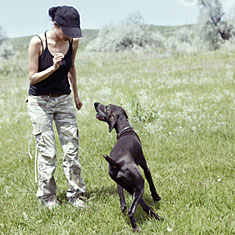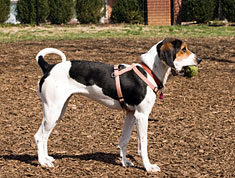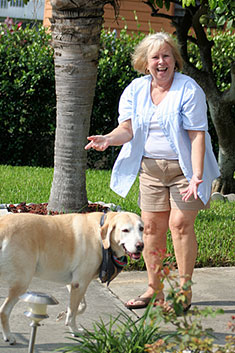Choosing a Trainer for Your Dog
When you bring home a new dog, one of the first things you may try to do is to train the dog in basic obedience. You can often find low-cost classes through your local kennel club or 4-H, but sometimes that's not enough to make an obedience star out of your new family member. If you decide to seek further professional help in training, our handy guide can help you find the right fit.
Precursors to training
Before you try to train a dog, you must establish a good relationship with the animal. For example, your dog must know that you can be trusted to look out for his best interests. When working with a puppy, this can be relatively easy to establish, as you will be feeding the dog and taking him for walks or doing other fun things.

For a dog who you have adopted, it may take months to establish this trust. The trust relationship you wish to develop has to fight against poor treatment the dog may have received earlier in life. If the dog was a stray, he may have been pushed away by storekeepers or homeowners when the trash looked like a food dish. If the dog was abused in a former home, you will have to overcome the mistrust the dog may now feel for all humans.
The second piece of preparing for training is to convince the dog that you are the pack leader. Dogs are pack animals, meaning they order their lives according to their position in the pack. Alpha dogs eat first, get the best of everything, and work unendingly at defending and proving their legitimacy as leader of the pack. In order to establish yourself as the head of your pack, you need to establish firm rules and stick to them.
This doesn't mean you have to be mean or have a deep commanding voice. It does mean you have to say what you mean and mean what you say. If you tell the dog to get off the couch and he doesn't, you must go over and help the dog down to the floor. If the dog is aggressive toward you, you may have to use a muzzle to protect yourself while you enforce your rules.
The final preparation for training is to establish the goals you have for your dog. Before you check out different trainers, you might want to make a list of what your goals are. Do you want to create an obedience champion or do you just want to cut down on counter-surfing and overly exuberant greeting of guests who come into your home? This will help you choose a trainer and develop a program that meets your needs.
Once you are sure your dog trusts and respects you, and you have defined what you want to get out of training, it is time to begin choosing between different methods of training.
Styles of training
Above all else, you want to make sure your trainer will use positive training methods with your dog. Under no circumstances should you allow a trainer to hit or otherwise abuse your dog. Doing so doesn't teach your dog anything, and can turn your dog into an aggressor.
Many types of training depend on sounds to either get your dog's attention, to reinforce correct behavior, or to distract the animal from doing something wrong. For example, some trainers work with a small chain or another device that will make noise when thrown near a dog. If your dog stops paying attention the chain can be thrown on the ground near the dog to re-gain their attention.
Some trainers use a clicker to help the dog realize that whatever task they have just completed is the correct one. The sound of the clicker is used to point out to the dog which behavior is the desired one because it is sounded as soon as the behavior is exhibited. This is said to help the dog sort out the wanted behavior from any other behaviors that might be done right before or right after the desired behavior.
Lastly, a distracting sound may be used to stop your dog the minute he starts to think about doing something wrong. For example, as your dog starts to look like he is going to jump up on the counter or table, you can shake an old soda pop can with a few pennies in it to distract the dog from his intended bad behavior
.Communicating with Your Dog
As you train, there are four basic messages you want your dog to understand:
- Good dog! This is often communicated by giving the dog a reward such as playtime or a treat.
- Keep going! This means that the dog has started to do the right behavior or has begun the sequence of behaviors you want to see. It also tells the dog that continuing along this path will result in a reward.
- No dice. This tells the dog that the behavior he or she is doing is not the one you are looking for, but the dog has not done something particularly objectionable.
- Bad move. This tells the dog that not only is he NOT doing what you want done, he is actively doing something you DON'T want to see.

You and your chosen trainer should establish how each of these messages will be communicated to your dog. Unless you will be turning your dog over to the trainer for complete immersion in a "training camp" you will have your dog at home with you more than he is with the trainer. It is important that you both use the same method of communicating to keep your dog from getting confused. Even if you send the dog away to training camp, you will need to know the messages the trainer gave so you can continue to reinforce the lessons when the dog comes home.
Choosing Rewards
When choosing a reward to give your dog, you must figure out what drives the dog. If your dog has a high food drive, it will do you no good to reward behavior with a toy, and vice versa. Placing a bowl of food and a few toys on the floor of a room, then leading your dog into the room can fairly easily determine this. Whichever he goes for most exuberantly is what you should use for training rewards.
However, if you have a small breed or a dog who is not very active, you will need to watch for obesity. Break treats into small pieces or make sure you walk your dog frequently to prevent weight gain from training treats.

Be Patient
Training a dog takes time, consistency, and commitment. You must commit to working with your dog every day, preferably for several sessions each day. Your dog's attention span is very short – possibly only five minutes for an adult dog and even less for a puppy. Try training in short spurts, several times a day to get the best results.
If there is more than one person in your house who will be working with the dog, check in with each other frequently to make sure you are giving consistent commands and have the same expectations. If Mom likes to snuggle with the dog on the couch while watching television, and Dad punishes the dog for jumping up on the furniture, it can be so confusing to the dog that he will never learn what is expected.
Finally, don't give up! Your dog will eventually realize that you are the alpha dog and are to be obeyed. Work with the dog consistently and give plenty of rewards when the correct behavior is achieved. If necessary, break the behavior into smaller pieces and reward each step toward the final product.
Doggies Den: Latest Articles
 Homemade Thanksgiving Treats for Your Dog
Homemade Thanksgiving Treats for Your Dog
NUTRITION We all want to include our dogs in our holiday celebrations, but hopefully, you're aware that sharing table scraps with your dog isn't always the best idea.
 Keeping Your Dog Safe during the Summer Months
Keeping Your Dog Safe during the Summer Months
HEALTH Summer is coming on fast, so it’s time to plan how you will keep your dog safe and healthy through the lazy, carefree, warm days.
 Vaccination Time Again-Keeping Your Puppy Healthy
Vaccination Time Again-Keeping Your Puppy Healthy
DOG HEALTH So you have your new puppy picked out. There are quite a few shots, treatments and examinations that will keep the newest member of your family healthy.
 Canine Thanksgiving Feast
Canine Thanksgiving Feast
NUTRITION With the wide variety of food at Thanksgiving dinner, chances are you'll want to give your dog something special, too. If you're contemplating what to feed your dog for the holiday, here is a guide to a great Canine Thanksgiving Feast.
 Dog Walking Tips Every Owner Should Know
Dog Walking Tips Every Owner Should Know
DOG FUN Walking your dog is not only crucial to keeping him healthy and happy, it strengthens the bond between your canine friend and his caregiver. There are a lot of obstacles out there. Don’t forget these simple tips to keep your walk fun and safe in the outside world.
 The Benefits of Physiotherapy for your Dog
The Benefits of Physiotherapy for your Dog
HEALTH The same techniques that physiotherapists use to treat a variety of injuries and conditions in humans have been adapted to suit animals with great success. Family pets, show dogs, and working dogs can all benefit greatly from physiotherapy. Dogs whose activities involve a lot of agility are especially susceptible to the types of problems that physiotherapy can address.
 The Decision- Adding a Dog to Your Family
The Decision- Adding a Dog to Your Family
FIRST TIME OWNERSBringing a dog into your family is a decision where many people don’t realize it’s magnitude until after they have the dog. There are a number of things that you need to research before you decide to purchase a dog, and it starts right in your own home.
 Bringing Your Dog Into Your New Baby's Life
Bringing Your Dog Into Your New Baby's Life
HEALTH Many believe that a dog and a new baby cannot happily coexist, so therefore the dog has to go. This is not necessarily the case.  A new baby does not mean you have to abandon your dog.

Doggies Den:
Most Popular Articles

Dog Pregnancy Symptoms
HEALTHIf you suspect your dog might be pregnant, check out part one in this series on pregnant dogs, where we cover pregnant dog symptoms.

Dog Birth
HEALTHIn the third article of our dog pregnancy series, we look at the wonderful, but messy, process of bringing newborn puppies into the world.

Indoor Dog Potties
DOG PRODUCTSIt's been a long day at work. You were so busy, you didn't even take time to eat a sandwich, let alone run home to let your dog out. You're on your way home, knowing the poor dog is crossing his or her legs by now, when your car breaks down, delaying you even further. Can't somebody make this easier?

Your Dog’s Digestive System
PHYSIOLOGYEver wonder why your dog eats so fast? Or why he eats gross things? Or why he gets sick to his stomach? Or why his waste stinks so bad? Some of these things are normal, some are not.

Canine Respiratory System
BREATHINGThe basic function of your dog's respiratory system is to bring oxygen in to and remove carbon dioxide from the body. Knowing the symptoms of respiratory diseases can help you help your stay healthy.

Shelter Dog Adoption Tips for Success
ADOPTION Are you intimidated by the prospect of "rescuing" a dog from a shelter? One reason that you may be wary of adopting a dog from a shelter is not knowing how to choose. Adopting a dog from a shelter can be a rewarding process, if you're prepared to do a reasonable amount of research.

Canine Urinary Tract Infections
SYMPTOMS AND TREATMENTDoes your dog seem to be having trouble relieving his or her bladder? Learn how to recognize the signs of urinary tract infections and how to treat them before they spread.

What to do for Dog Diarrhea
SYMPTOMS AND REMEDIESIf you have dogs in your house for any length of time, you have likely experienced at least one bout of dog diarrhea. Beyond the pain in the tuckus involved in cleaning up the mess, you should know what causes diarrhea, and when it's important to see the vet.

What to do for a Dog Bite
DOG BEHAVIOR Getting bitten by a dog can be scary, and you may be tempted to run around in circles for a while, trying to figure out what to do. Here's our guide to help you manage the situation.

Top Ten Tips for Living with a Senior Dog
DOG HEALTH Bringing home a new puppy is so exciting, but it doesn’t take all that long for your exuberant puppy to grow into a senior dog who may have special needs. Here are the doggies.com top ten tips for taking care of your companion who has been with you through so much.
